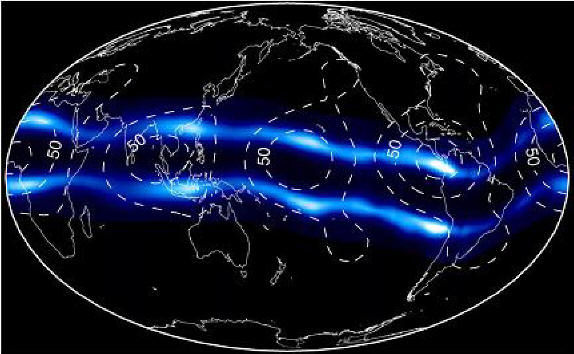|
|
Plasma In Three Dimensions
Jan
20, 2010
Plasma is
often described as the fourth state
of matter. Since it makes up more
than 99% of the Universe, it should
be reckoned the first state.
It was in September of 2006 that a
major premise of Electric Universe
theory was confirmed: Earth weather
is electrically connected to the
ionosphere. Since electricity always
flows in a circuit, if the
ionosphere connects to Earth's
magnetosphere then it connects to
the circuits of the Solar System, as
well.
Although the general premise is
probably thousands of years old—that
Earth is somehow an electrical
entity—it has only been in the last
100 years that scientists have given
serious credence to the possibility
that we could be living in a dynamic
Solar System where electricity plays
an important role.
Earth's polar aurorae are further
evidence of this connection, as are
high-altitude discharges known as
red sprites and blue jets. Sprites
and jets carry charge distribution
from lower atmospheric layers into
the ionosphere. They are usually
seen high above thunderstorms, so
high that the storm is sometimes
below the horizon when the
phenomenon occurs.
Space shuttle flights have recorded
the glow from sprites and jets as
they launched upward toward space.
They are essentially reverse
lightning bolts—beginning as
powerful upward strokes that rapidly
diminish into small filaments—and
seem to be closing the circuit
between the cloud tops and the
ionosphere.
The electric charges flowing out of
the Sun, on the other hand, travel
down magnetic flux tubes that have
also recently been discovered. These
"magnetic tornadoes" are several
kilometers wide and allow electric
currents to flow directly from the
Sun into the polar regions,
generating visible light, radio
waves, and x-rays.
The power generated by an auroral
substorm is far greater than what
human beings can create with every
coal-burning, oil-fired, or
water-driven means combined. These
currents are comprised of widely
separated, low density charged
particles and are called Birkeland
currents. Despite the low current
density, the volume of charge is so
great that there is an extremely
high overall current flow, over a
million amps.
It is common among planetary
scientists to talk about plasma, but
to do so in a way that makes its
electrical nature seem to be of
little import. Solar "wind," "a
rain" of charged particles, ionic
"impacts," "clouds of ionized gas":
such terms are meant to convey the
inertial aspects of plasma and
reduce it to nothing more than hot
gas and dust. Because
astrophysicists are convinced that
electricity is not a factor when
dealing with objects in space, the
fact that plasma can act with forces
39 orders of magnitude greater then
gravity is virtually ignored.
An electric discharge in plasma
creates a tube-like magnetic sheath
along its axis. If enough current
flows through the circuit, the
discharge will cause the sheath to
glow, sometimes creating a number of
other sheaths within it. The sheath
is called a “double layer.”
Double layers form when positive
charges build up in one region of a
plasma cloud and negative charges
build up nearby. A powerful electric
field appears between the two
regions, which accelerates charged
particles. The electric charges
spiral in the magnetic fields,
emitting x-rays, extreme
ultraviolet, and sometimes gamma
rays.
Every world in the solar system is a
charged body orbiting in a plasma.
There are many ways in which plasma
interacts with dust or atmospheric
gases no matter how hot or cold they
are. Spacecraft sent to other
planets, as well as satellites
orbiting our own planet, have
detected aurorae, lightning,
tornadoes and dust devils.
Large magnetic fields have been
detected in galaxies, and those
fields indicate that Birkeland
currents flow in circuits through
them. The current-induced magnetic
forces pull the currents into
filaments, twist the filaments
around each other, and then "pinch"
the galactic plasma until the
internal pressure balances the
magnetic constriction. Stars will
form like beads along a galactic
wire, that wire being a Birkeland
current filament.
Volcanoes on Earth have been found to
“spit lightning” from their vents. Global
dust storms on Mars are shown to be fed
by thousands of sky-high funnels. Further into the solar system remote
instruments are finding radio noise,
electrified comets, spokes in Saturn’s
rings and many other modes of electrical activity.
It is rare to read a report in a
science news magazine that discusses
the electrical nature of plasma and
its role in the Universe. As more
instruments capable of measuring the
plasma environment of space are
built and more sensitive detectors
are sent out to the various planets,
moons, comets, and eventually,
nebulae, the Electric Universe
paradigm will only gain more
support. And that is not hot gas.By Stephen Smith
|
|
|
|
|
|
|
|
|
YouTube video, first glimpses of Episode Two in the "Symbols of an Alien Sky"
series.
|
|
|
|
|
|
|
Three ebooks in the Universe Electric series are
now available. Consistently
praised for easily understandable text and exquisite graphics.
|
|
|
|
|
|
|
|
|
|







